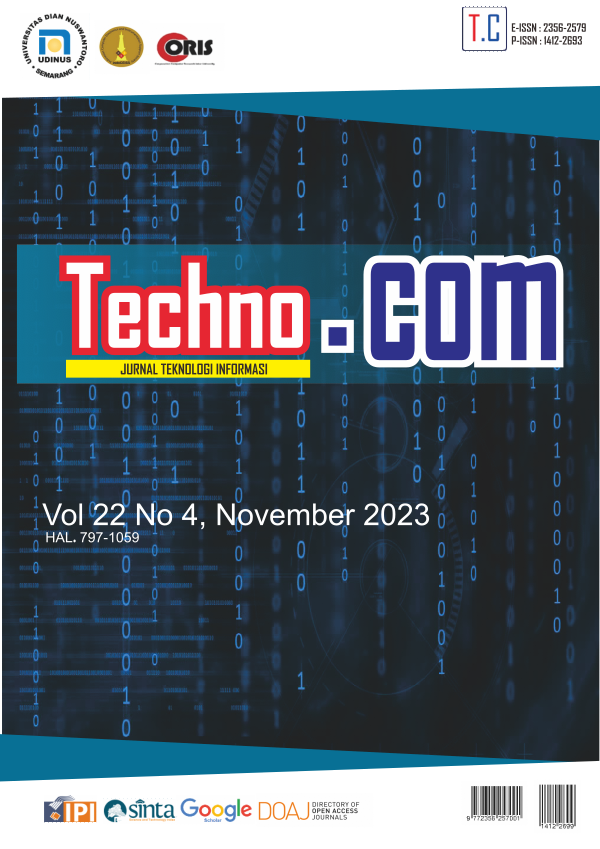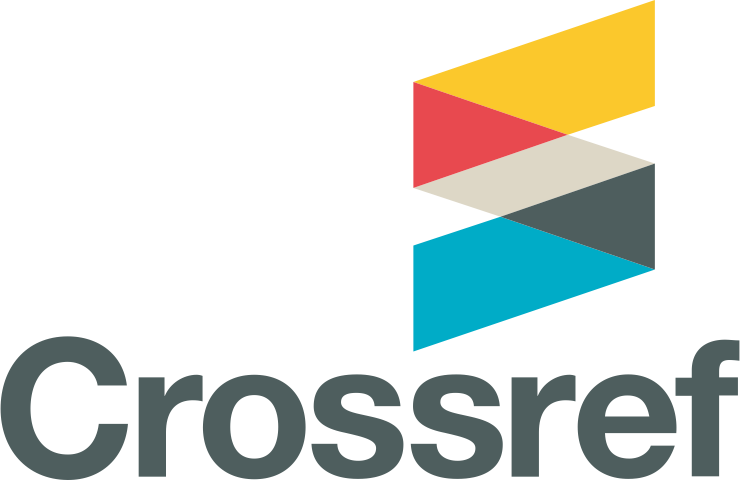Pengembangan Metode Routing Menggunakan Mekanisme Swing Routing dengan Penanganan Routing Hole Sebagai Peningkatan Kinerja Wireless Sensor Network
DOI:
https://doi.org/10.33633/tc.v22i4.8965Keywords:
wireless sensor network, swing routing, Routing hole, SIDnet-SWANSAbstract
WSN menggunakan jaringan nirkabel untuk menghubungkan node sensor dan sink node. Node sensor bertugas mengumpulkan informasi dengan melakukan sensing terhadap target seperti panas, cahaya, dan suhu. Namun, node sensor memiliki keterbatasan dalam hal memori, sumber daya pengolahan, energi, dan masa pakai, yang dapat mempengaruhi kinerja jaringan, termasuk network lifetime dan packet delivery ratio. Oleh karena itu, diperlukan protokol yang efektif untuk meningkatkan kinerja jaringan WSN. Salah satu penelitian untuk meningkatkan kinerja jaringan adalah menggunakan Shortest Geopath Routing (SGP) berbasis tetangga terdekat dan lokasi. Namun, SGP memiliki permasalahan seperti seringnya terjadi kongesti yang menyebabkan packet drop dan kegagalan pengiriman data saat terjadi Routing hole. Untuk mengatasi permasalahan tersebut, penelitian ini melakukan protokol SGP dengan mekanisme Swing routing untuk meningkatkan kinerja jaringan WSN. Dalam mengatasi Routing hole, Swing routing Protocol juga melakukan pencarian jalur alternatif dengan memilih node berdasarkan lokasi koordinat terdekat dengan sink node. Hasil simulasi menggunakan simulator SIDnet-SWAN menunjukkan bahwa penggunaan Swing routing Protocol dapat mengurangi warning congestion dalam jaringan sebesar rata-rata 10 node, meningkatkan network lifetime sebesar 5.27% (14 menit), dan meningkatkan packet delivery ratio sebesar 8.27% dibandingkan dengan protokol SGP. Dalam penanganan Routing hole, Swing routing Protocol mendapatkan rata-rata packet delivery ratio sebesar 21.77% dibandingkan dengan protokol SGP.References
B. R. Mehta dan Y. J. Reddy, “Wireless communication,” in Industrial Process Automation Systems, Elsevier, 2014, hal. 417–457.
H. Frey dan I. Stojmenovic, “Geographic and Energy-Aware Routing in Sensor Network,” in Handbook of Sensor Networks: Algorithms and Architectures, New Jersey: John Wiley & Sons, Inc., 2005, hal. 381–415.
D. F. Jenolin Flora, V. Kavitha, dan M. Muthuselvi, “A survey on congestion control techniques in Wireless sensor Networks,” in 2011 International Conference on Emerging Trends in Electrical and Computer Technology, Mar 2011, hal. 1146–1149, doi: 10.1109/ICETECT.2011.5760292.
C. Sergiou, V. Vassiliou, dan A. Paphitis, “Hierarchical Tree Alternative Path (HTAP) Algorithm for congestion control in wireless sensor networks,” Ad Hoc Networks, vol. 11, no. 1, hal. 257–272, Jan 2013, doi: 10.1016/j.adhoc.2012.05.010.
S. Toumpis dan L. Tassiulas, “Optimal deployment of large wireless sensor networks,” IEEE Trans. Inf. Theory, vol. 52, no. 7, hal. 2935–2953, Jul 2006, doi: 10.1109/TIT.2006.876256.
C. Sergiou, V. Vassiliou, dan A. Paphitis, “Congestion control in Wireless sensor Networks through dynamic alternative path selection,” Comput. Networks, vol. 75, hal. 226–238, Des 2014, doi: 10.1016/j.comnet.2014.10.007.
N. Ahmed, S. S. Kanhere, dan S. Jha, “The holes problem in wireless sensor networks,” ACM SIGMOBILE Mob. Comput. Commun. Rev., vol. 9, no. 2, hal. 4–18, Apr 2005, doi: 10.1145/1072989.1072992.
A. Maghsoudlou, M. St-Hilaire, dan T. Kunz, “A survey on Geographic routing Protocols for mobile ad hoc networks.,” 2011.
J. C. Navas dan T. Imielinski, “GeoCast---Geographic addressing and routing,” in Proceedings of the 3rd annual ACM/IEEE international conference on Mobile computing and networking - MobiCom ’97, 1997, hal. 66–76, doi: 10.1145/262116.262132.
O. C. Ghica, G. Trajcevski, P. Scheuermann, Z. Bischof, dan N. Valtchanov, “SIDnet-SWANS: a simulator and integrated development platform for sensor networks applications,” in Proceedings of the 6th ACM conference on Embedded network sensor systems, Nov 2008, hal. 385–386, doi: 10.1145/1460412.1460464.
C.-Y. Wan, S. B. Eisenman, dan A. T. Campbell, “CODA: congestion detection and avoidance in sensor networks,” in Proceedings of the 1st international conference on Embedded networked sensor systems, Nov 2003, hal. 266–279, doi: 10.1145/958491.958523.
L. Popa, C. Raiciu, I. Stoica, dan D. Rosenblum, “Reducing Congestion Effects in Wireless Networks by Multipath Routing,” in Proceedings of the 2006 IEEE International Conference on Network Protocols, Nov 2006, hal. 96–105, doi: 10.1109/ICNP.2006.320202.
R. Sarkar, X. Y. Gu, J. Gao, F. Luo, dan X. David, “Greedy routing with guaranteed delivery using Ricci flows,” 2009 Int. Conf. Inf. Process. Sens. Networks, hal. 121–132, 2009.
M. M. Lima, H. A. B. F. Oliveira, D. L. Guidoni, dan A. A. F. Loureiro, “Geographic routing and hole bypass using long range sinks for wireless sensor networks,” Ad Hoc Networks, vol. 67, hal. 1–10, Des 2017, doi: 10.1016/j.adhoc.2017.08.010.
C.-H. Tsai, Y.-H. Wang, dan L.-Y. Lee, “A Hole Avoiding Routing Protocol using a relative neighborhood graph for wireless sensor networks,” J. Internet Technol., vol. 14, no. 7, hal. 1021–1031, 2013, doi: 10.6138/JIT.2013.14.7.02.
P. Bose, P. Morin, I. Stojmenovi?, dan J. Urrutia, “Routing with guaranteed delivery in ad hoc wireless networks,” in Proceedings of the 3rd international workshop on Discrete Algorithms and methods for mobile computing and communications, Agu 1999, hal. 48–55, doi: 10.1145/313239.313282.
Y. Xue, X. Chang, S. Zhong, dan Y. Zhuang, “An efficient energy hole alleviating Algorithm for wireless sensor networks,” IEEE Trans. Consum. Electron., vol. 60, no. 3, hal. 347–355, Agu 2014, doi: 10.1109/TCE.2014.6937317.
Downloads
Published
Issue
Section
License
Copyright (c) 2023 Novi Trisman Hadi, Muhammad Panji Muslim, Nindy Irzavika

This work is licensed under a Creative Commons Attribution-NonCommercial 4.0 International License.
License Terms
All articles published in Techno.COM Journal are licensed under the Creative Commons Attribution-NonCommercial 4.0 International (CC BY-NC 4.0). This means:
1. Attribution
Readers and users are free to:
-
Share – Copy and redistribute the material in any medium or format.
-
Adapt – Remix, transform, and build upon the material.
As long as proper credit is given to the original work by citing the author(s) and the journal.
2. Non-Commercial Use
-
The material cannot be used for commercial purposes.
-
Commercial use includes selling the content, using it in commercial advertising, or integrating it into products/services for profit.
3. Rights of Authors
-
Authors retain copyright and grant Techno.COM Journal the right to publish the article.
-
Authors can distribute their work (e.g., in institutional repositories or personal websites) with proper acknowledgment of the journal.
4. No Additional Restrictions
-
The journal cannot apply legal terms or technological measures that restrict others from using the material in ways allowed by the license.
5. Disclaimer
-
The journal is not responsible for how the published content is used by third parties.
-
The opinions expressed in the articles are solely those of the authors.
For more details, visit the Creative Commons License Page:
? https://creativecommons.org/licenses/by-nc/4.0/
















